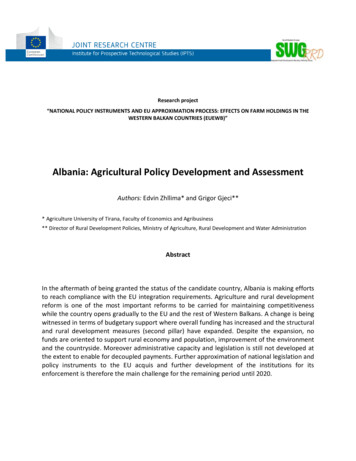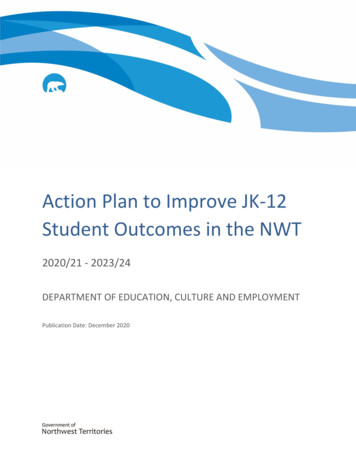
Transcription
Action Plan to Improve JK-12Student Outcomes in the NWT2020/21 - 2023/24DEPARTMENT OF EDUCATION, CULTURE AND EMPLOYMENTPublication Date: December 2020
Table of ContentsTable of Contents . 2Purpose of the Action Plan . 3Education Renewal and Innovation Framework Formative Evaluation . 3OAG Performance Audit on Early Childhood to Grade 12 Education . 4Operating Environment of Licensed Early Learning and Child Care Programs . 5Governance Structure . 5Context of the Early Learning and Child Care Programs . 5How does ECE support operators in the delivery of Licensed Early Learning and Child Care Programs? . 6Operating Environment of the JK-12 Education System . 7Governance Structure . 7Context of the Education System . 7How does ECE support Education Bodies in the Delivery of the Education system? . 8ECE’s Approach to Improving Student Outcomes . 9Linkage to the GNWT Priority and Mandate . 9Quality Licensed Early Learning and Child Care Programs . 9Education Renewal and Innovation Framework . 10Action Plan Development . 10Monitoring and Evaluating ECE’s Efforts . 12Appendix 1: Action Plan to Improve JK-12 Student Outcomes . 14Theme 1: Quality Early Learning and Child Care . 14Theme 2: Workforce Development and Capacity Building . 16Theme 3: Curriculum and Student Assessment . 18Theme 4: Student Supports . 20Theme 5: Training, Developing and Support for School Employees . 23Theme 6: Governance . 26Theme 7: Monitoring and Evaluation . 29Appendix 2: Actions to respond to OAG recommendations . 31Appendix 3: Performance Measures of the JK-12 Education System . 33Input Performance Measures. 34Outcome Performance Measures . 35December 18, 2020Department of Education, Culture and EmploymentPage 2 of 33
Purpose of the Action PlanIn 2018-2019, the Department of Education, Culture and Employment (ECE, Department) conducted a FormativeEvaluation of the Education Renewal and Innovation Framework (ERI Evaluation). During the same time, theOffice of the Auditor General of Canada (OAG) conducted a performance Audit (OAG Audit) of early childhood toJunior Kindergarten to Grade 12 (JK-12) education in the Northwest Territories (NWT). Both the ERI Evaluationand the OAG Audit generated several recommendations to improve student outcomes in the NWT; most of whichoverlapped specific to the area of JK-12 education1. ECE fully agrees with the recommendations made in the OAGaudit report. Rather than develop separate Action Plans to respond to the recommendations of each report, thisAction Plan identifies how ECE plans to implement actions to address the recommendations contained in bothreports and complete the 10 year ERI Framework.ECE remains cognizant that the development and implementation of this Action Plan is just one step towardimproving student outcomes. If this Action Plan is to have much success, education bodies, Indigenousgovernments and organizations, communities, educators, families, and students themselves must have a role toplay in improving student outcomes in the NWT.Education Renewal and Innovation Framework Formative EvaluationThe Education Renewal and Innovation Framework (ERI): Directions for Change is guiding the education system.This document was published in October 2013, following years of extensive engagement, research, and planning.After its publication in 2013, the first 3-year Action Plan in 2014 was developed. This was the beginning of a 10year process intended to change the NWT’s education system for the purpose of improving student experiencesand outcomes, and to better support the development of NWT students as healthy, capable people.The end of the 2018-2019 fiscal and school years marked the end of the first five years of ERI. At this halfwaymark in ERI’s lifespan, ECE undertook a formative evaluation to assess the work undertaken as part of ERI, to seewhether the Department was on track to achieve the comprehensive changes the Framework proposed. Theevaluation also addressed ECE’s Planning and Accountability Framework requirements to complete acomprehensive, outcomes-oriented review of the education system against its overall mandate every five years.Thus, ERI’s implementation at its five year mark was used as the foundation for this review and used to helpinform changes to the education system moving forward.The evaluation answered three questions:1. What are the ERI goals and commitments, and how are they measured?2. How were the ERI commitments implemented?3. What are the results of ERI initiatives and how are these initiatives contributing to the ERIcommitments?Each of these questions were answered through a mixed-methods approach analysis of approximately 32performance measures established for the education system, and an in-depth examination of nine ERI initiativesusing a case study approach.Department staff were provided opportunities to review draft versions of the report, case studies andrecommendations. Feedback from Department staff was incorporated into the final version of the 2019Education Renewal and Innovation Framework: Formative Evaluation Report (ERI Evaluation).1The ERI Evaluation did not examine early childhood programming.December 18, 2020Department of Education, Culture and EmploymentPage 3 of 33
OAG Performance Audit on Early Childhood to Grade 12 EducationIn March 2018, the OAG announced that they would undertake a Performance Audit in the area of early childhoodto Grade 12 education. Through their examination, the OAG covered the period of April 01, 2015 to May 31,2019.Based on initial interviews with ECE about its programs and services, the OAG narrowed the focus of the audit toexamine whether ECE planned, supported, and monitored the delivery of equitable inclusive education programsand services that reflected Indigenous languages and cultures to support student outcomes and close keyachievement gaps.Specifically, the OAG examined ECE’s responsibilities in the following areas: Inclusive Schooling;Indigenous languages and culture-based education;Equitable access to quality education;Programming, staff qualifications, and training in day cares; andKey student outcomes.ECE staff provided support and all documentation related to the scope of the audit, participated in a number ofinterviews and answered various follow up questions, as required, during the OAG’s planning, examination andreporting phases.In addition to conducting interviews with departmental staff as part of the examination phase, the OAG alsotravelled to communities to carry out interviews with various stakeholders across education bodies and schools.Consistent with other audits completed by the OAG, the Department was provided the opportunity to review adraft of the report and the recommendations. ECE accepted all recommendations contained in the report andprovided responses to the recommendations which are contained in the final audit report.After completing their work, the OAG tabled the Report of the Auditor General of Canada to the NorthwestTerritories Legislative Assembly – 2016: Early Childhood to Grade 12 Education in the Northwest Territories (theOAG Audit) on February 6, 2020.December 18, 2020Department of Education, Culture and EmploymentPage 4 of 33
Operating Environment of Licensed Early Learning and Child Care ProgramsGovernance StructureECE is responsible for regulating the NWT’s early learning and child care sector and ensuring compliance with theNWT Child Day Care Act and Standards Regulations. The NWT Child Day Care Act (the Act) is the legislation thatoutlines how children should be cared for in facilities outside of their homes in the NWT. The Child Day CareStandards Regulations further explain the Act and specify ratios for early childhood educators and children,documentation, including health and safety inspections of the facility, and minimum education requirements forprimary staff.The early childhood sector in the NWT includes licensed centre-based and out-of-school (before and after school)programs and licensed family day homes. There are unlicensed family day homes that ECE does not track,regulate or fund but enforces compliance with the maximum ratio standards in accordance with the NWT ChildDay Care Act and Standards Regulations.The Department does not deliver early childhood programs directly to children and families. Not-for-profitcommunity organizations, Indigenous Governments, and individuals operate early learning and child careprograms; which may be overseen by boards composed of stakeholders who represent the community’s interestsand contexts on behalf of children and families enrolled in programs.Context of the Early Learning and Child Care ProgramsIn March 2019, there were 113 licensed early learning and child care programs in the NWT; 35 centre-basedprograms; 27 out-of-school (before and after school) programs; and, 51 family day homes. As of December 2019,the NWT has 116 licensed early learning and child care programs operating throughout the NWT. The majority(approximately 60%) of licensed programs are located in Yellowknife. In fiscal year 2018-19, the departmentallocated nearly 12,390,900 million in federal and territorial funding to support early childhood development.This is in addition to funding provided by other social envelope departments, such as the Department of Healthand Social Services (HSS), to support children and families from prenatal and throughout their childhood.Of the 33 communities in the NWT, 11 communities do not have licensed early learning and child care programs;this number fluctuates over time. ECE works with communities to identify their needs and support theestablishment of programming that best meets those needs.The NWT has a high percentage of children who are vulnerable requiring additional supports as indicated by theEarly Development Instrument (EDI). The EDI is a population-based measurement of children’s developmentalhealth. It is a reflection of the early childhood experiences prior to age five and indicates the percentage ofchildren who are on-track, at-risk, or vulnerable. Children are considered vulnerable when, without additionalsupport, they may continue to experience challenges. ECE recently published the Early Development Instrument(EDI) Measuring Children’s Developmental Health NWT Change Over Time Report 2012-2017. The Change OverTime Report suggests a trend of increased vulnerability over time in the NWT (an increase from 38.1 to 42.1% inthe six-year time period).December 18, 2020Department of Education, Culture and EmploymentPage 5 of 33
How does ECE support operators in the delivery of Licensed Early Learning and Child Care Programs?Understanding unique community needs and preferences for early learning and child care as noted above is animportant consideration when determining what supports should be offered to a community.ECE has an Early Learning and Child Care (ELCC) Division, located in Yellowknife, comprised of eight staff, andseven Early Childhood Consultants (ECCs) who work out of the regional ECE Service Centres. The ELCC Division isresponsible for ensuring that both licensed and unlicensed programs comply with the legislation. This includesfunding, licensing, inspecting and providing ongoing support to not-for-profit organizations, Indigenousgovernments and individuals who operate early learning and child care programming. ECE licenses and inspectsprograms; ECE does not deliver early learning and child care programming. Where there is interest from nonprofit organizations, Indigenous governments and individuals, ECCs work with those parties to support themthrough the process, in order to meet the requirements for licensing.In addition to supporting the establishment of licensed programs, ECE provides funding towards theestablishment and ongoing sustainability of licensed programs. This includes the New Child Care Spaces funding(or start-up funding), Early Childhood Program (ECP) attendance-based operating subsidy, health and safetyfunding to assist with health and safety repairs and maintenance as required by Environmental Health and/or theOffice of the Fire Marshal. ECE provides one-time grants to help programs purchase resources, including: theProvider Enhancement Grant (PEG), the Cultural Resources Grant, and the Technology Grant.ECE is phasing in Supporting Child Inclusion and Participation (SCIP) funding, which will replace the HealthyChildren Initiative (HCI) funding. SCIP is focused on supporting children who may be at-risk and/or have specificdevelopmental needs. SCIP funding can be accessed by licensed and unlicensed programs through a proposalbased process.ECE also supports access to quality early learning and child care programs by providing professional developmentand in-service opportunities to early childhood educators. Funding is provided for the delivery of Aurora College’sfull-time Early Learning and Child Care (ELCC) Diploma in Yellowknife and part-time distance delivery of thecertificate program. These supports help address the quality of early learning and child care programs. ECE is inthe process of piloting the NWT Early Learning Framework (ELF) which is an overarching document that isintended to support the professional practice of educators that work with young children in licensed earlylearning and child care programs prior to school entry. The ELF identifies knowledge and practices that areessential for quality early childhood programs, as they nurture the learning and development of young childrenwithin a variety of contexts.December 18, 2020Department of Education, Culture and EmploymentPage 6 of 33
Operating Environment of the JK-12 Education SystemGovernance StructureECE is responsible for the NWT’s education system from JK-12. The system consists of the Department and 10education bodies (similar to school boards).The NWT Education Act defines the powers and responsibilities of the Minister, education bodies, education staff,students and parents. It further defines provisions regarding access, records, resolution and appeals mechanisms,cultural diversity and language of instruction, and governance and financial matters.Although the Department does not deliver services directly to students, it is responsible for ensuring that allstudents have equitable access to education programs and services. Under the Education Act, responsibility forthe delivery of education belongs to the education bodies. Education bodies are composed of elected and/orappointed individuals who represent their community’s interests in the planning and delivery of educationalprogramming for their school(s).Each education body has a Chairperson who represents their region at the Education Leaders’ forum with theMinister. Education body Chairs do not only represent their regions and communities; their responsibility extendsto collective work towards common goals and priorities for the NWT education system as a whole.There are eight Superintendents responsible for providing overall leadership for their education body, whichconsist of District Education Authorities (DEAs) and Divisional Education Councils (DEC), and to the schools in theirDEC or DEA.The NWT Superintendents’ Association (NWTSA) meets regularly with the ECE Assistant Deputy Minister,Education and Culture and other senior departmental officials. This NWTSA-ECE Committee is responsible foradvancing work as directed by the Minister and Education Leaders, and carrying out administrative / operationalwork.Context of the Education SystemThe history and legacy of residential schools continues to affect students and their families in all regions of theNWT. This is an important, overarching reality when considering the context of education in the NWT.The Education Act specifies that students in the NWT must have access to education programs that meet thehighest possible standards and that reflect NWT cultures. Students may receive their education in one of theNWT's 11 official languages, nine of which are Indigenous. The Education Act also states that every student isentitled to access the regular education program in their home community and receive the support servicesnecessary to do so.Education bodies employ about 850 educators and oversee operations to deliver education to approximately8,700 students at 49 schools. The majority of NWT schools are very small. About 60% of schools have fewer than150 students, and about 12% of schools have fewer than 20 students. Nine of the smallest schools do not offer agrades 10-12 high school program.Small schools, even those with a high school program, are often unable to offer the same educationalprogramming options as larger schools in Yellowknife and regional centres; however, ECE has developedinitiatives to support the increased provision of equitable access to education for all students. Examples includethe introduction of the Northern Distance Learning program as well as the Career and Education Advisors.December 18, 2020Department of Education, Culture and EmploymentPage 7 of 33
Just over 60% of NWT students are Indigenous and the student population in most of the smallest schools is 100%Indigenous. Despite these high percentages, the recruitment of local Indigenous teachers and Indigenouslanguage instructors is a significant challenge for education bodies.Educator recruitment and retention, overall, is also an ongoing challenge for education bodies, particularly insmall remote communities, which are often coupled with limited access to adequate and affordable housing,licensed early learning and child care programs, health care, and other services.In the 2018-2019 fiscal year, ECE allocated nearly 155 million to the education bodies, which is nearly 50% of theDepartment’s budget. The education bodies then use this funding to deliver the education program in thefollowing categories, which align with the NWT School Funding Framework: Administration and School ServicesTerritorial SchoolsInclusive SchoolingIndigenous Languages and Education.While the majority of this funding is budgeted and spent at the discretion of education bodies, funding allocatedspecially for Inclusive Schooling and Indigenous Languages and Education is conditional funding that must be usedas directed by either the Ministerial Directive on Inclusive Schooling (2016) or the Indigenous Languages andEducation Policy (2018).How does ECE support Education Bodies in the Delivery of the Education system?Education bodies are supported by four divisions and a secretariat at ECE: Early Learning and Child Care (ELCC);Curriculum Development and Student Assessment (CDSA); Educator Operations and Educator Development(EOED); Student Support and Wellness (SSW); and the Indigenous Languages and Education Secretariat (ILES)These divisions work closely with education bodies with the goal of increasing student education outcomes, andthey also contribute to the GNWT’s mandate item of implementing United Nations Declaration on the Rights ofIndigenous Peoples (UNDRIP) through school-based Indigenous language and culture programming. Thesedivisions are also responsible for the following core business activities: the development and implementation ofcurriculum standards; development, implementation and monitoring of Ministerial Directives for educationbodies; teacher, principal and instructor certification, training and professional development; and theimplementation of accountability mechanisms for education bodies.ECE provides funds directly to education bodies to deliver the Junior Kindergarten to Grade 12 (JK-12) educationprogram.December 18, 2020Department of Education, Culture and EmploymentPage 8 of 33
ECE’s Approach to Improving Student OutcomesLinkage to the GNWT Priority and MandatePriorities of the 19th Legislative Assembly specific to early learning and child care are to improve early childhooddevelopment indicators for all children, and to advance universal child care by increasing availability andaffordability. Improving early development indicators for all children is an ongoing focus for the Department ofECE in collaboration with HSS. The development and piloting of the ELF for licensed early learning and child careprograms is one way that ECE will contribute to the quality of early experiences for children. With free, playbased JK/K programming for four and five year old children in the NWT, the focus to enhance the availability andaffordability of early learning and child care will be for families with children from birth to age three.Specific to the JK-12 system, increasing student education outcomes to the same level as the rest of Canada is apriority of the 19th Legislative Assembly, as is implementing the UNDRIP. Despite efforts to improve studentoutcomes and the progress made in some areas, the findings from both the OAG Audit and the ERI Evaluation areclear: Key achievement gaps have persisted, especially for students in small communities;Need to focus on more equitable programming;The system is overstretched and needs to focus its priorities; andNeed to do a better job of monitoring the system to determine whether the work ECE isundertaking is making any difference to close the achievement gap.In order for the NWT to address the priorities of the 19th Legislative Assembly, difficult and strategic decisionsneed to be made from early learning and child care programs through to Grade 12 education. These decisionsneed to be made collaboratively with partners, including Education Leaders, Indigenous governments, NWTSA,and the NWT Teachers’ Association (NWTTA).The first step to making these decisions requires ECE to focus on minimizing barriers to student learning, to allowfor system-wide improvements that the JK-12 system will be held accountable for, and that align with the realityof limited resources. The decisions will also have to balance the need for consistency in education standardsacross the NWT with the ability of Indigenous governments and communities to influence the education programin a way that supports and reflects the language and culture of the community.Quality Licensed Early Learning and Child Care ProgramsHigh quality early learning and child care programs delivered by qualified early childhood educators can helpprepare children for success in future school years. Through the three early childhood action plans, ECE is focusedon providing professional development and in-servicing opportunities and increasing access to quality earlylearning and child care programming throughout the territory. Recognizing that each community has uniqueneeds, ECE has engaged with the 11 communities without licensed programming to determine what will best suittheir needs. ECE and HSS work collaboratively to implement the Right from the Start Early ChildhoodDevelopment (RFTS ECD) Action Plan. In addition, ECE is implementing the ELCC Bilateral Agreement and ActionPlan and Supporting Access to Child Care Supplementary Action Plan which align with the RFTS ECD Action Plan.December 18, 2020Department of Education, Culture and EmploymentPage 9 of 33
Education Renewal and Innovation FrameworkRecognizing the challenges in the elementary and secondary education system, ECE began transformative work in2013-2014, with the implementation of the ERI Framework: Directions for Change and associated Action Plan.The Framework established a 10-year comprehensive rethink of the education system and encompassesnumerous actions and innovative approaches to improving equitable education access and student outcomesacross the NWT.The end of the 2018-2019 fiscal and school years marked the end of the first five years of the ERI Framework. Atthis halfway mark in ERI’s lifespan, ECE wanted to review the work undertaken as part of ERI to see whether theDepartment was on track to achieve the ambitious changes proposed and anticipated by ERI. To do this, ECEundertook a formative evaluation of the ERI Framework to assess the early implementation and results of thework undertaken to date, to help inform changes moving forward in order to meet its goals.Now in the seventh year of research, development and implementation, ECE is using the results of the evaluation,the OAG Audit and the mandate of the 19th Legislative Assembly to refocus the ERI initiatives in efforts to improvestudent outcomes.Decreasing the achievement gaps between Indigenous and non-Indigenous students, or between smallcommunities and larger centres, really means addressing the inequities students and schools face, which is oftenrelated to student wellbeing. With that said the purpose of ERI remains the same; implementing initiatives toimprove the NWT education system for all learners so that they can meet the challenges of today as capablenorthern citizens.Action Plan DevelopmentThe ERI Evaluation and the OAG Audit reconfirmed the need for changes to be made to the education system andeducational programming based on experience, research and analysis as identified by the ERI Framework.ECE has created a revised Action Plan for ERI that follows ECE’s approach to improving student outcomes; firststarting with actions that focus on quality early learning and child care, through to those actions that support aquality JK-12 education system.The development of this action plan was the result of numerous meetings with education branch staff, includingextensive engagements with the NWT Superintendents Association (NWTSA) to ensure an operational lens wastaken into consideration. These meetings and engagements involved in depth analysis of current and futureplanned initiatives, considering their successes, challenges and overall benefits to the education system. Thesediscussions also focused on system-wide capacity to manage and absorb change.A revisioning and development of shared priorities with NWTSA helped to focus decisions on what initiativesshould be kept or added, and what initiatives might not continue. The resulting shared priorities were agreed toby Education Leaders and the Department of ECE:1.2.3.4.5.Student achievement in Literacy and NumeracyLanguage and CultureStudent & Educator WellnessPersonalized and Inclusive EducationKey CompetenciesDecember 18, 2020Department of Education, Culture and EmploymentPage 10 of 33
Throughout this process, all recommended actions have been linked to either the recommendations of the ERIEvaluation, the results of the OAG Audit Report, the mandate of the 19th Legislative Assembly or the nine ERIcommitments.The actions are categorized into the following seven themes: Theme 1: Quality Early Learning and Child CareTheme 2: Workforce Development and Capacity BuildingTheme 3: Curriculum and Student AssessmentTheme 4: Student SupportsTheme 5: Training, Developing and Support for School EmployeesTheme 6: GovernanceTheme 7: Monitoring and EvaluationFor each of these themes, actions to support educational outcomes in small community schools are prioritized,but are not the sole focus of the themes. Rather, as a result of the Minister’s responsibility to provide qualityeducation to the territory as a whole, ECE’s actions must also focus on providing supports to all schools,regardless of size. This has been the approach taken to-date for all ERI actions, where all actions are intended tosupport ERI Commitment #5: The GNWT will do its part to ensure that the strengt
Action Plan to Improve JK-12 Student Outcomes in the NWT 2020/21 - 2023/24 DEPARTMENT OF EDUCATION, CULTURE AND EMPLOYMENT . (ECCs) who work out of the regional ECE Service Centres. The ELCC Division is responsible for ensuring that both licensed and unlicensed programs comply with the legislation. This includes funding, licensing, inspecting .
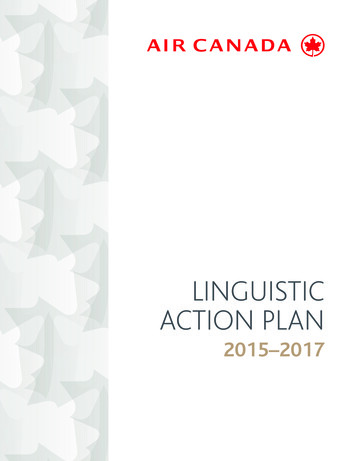





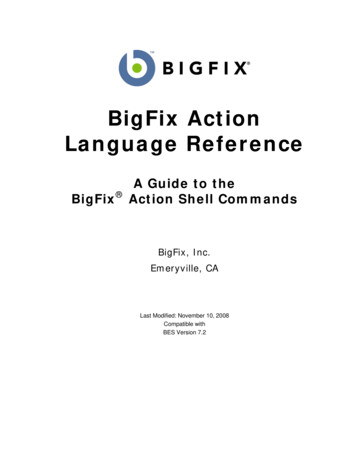

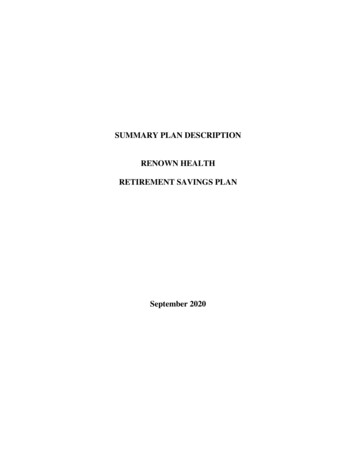
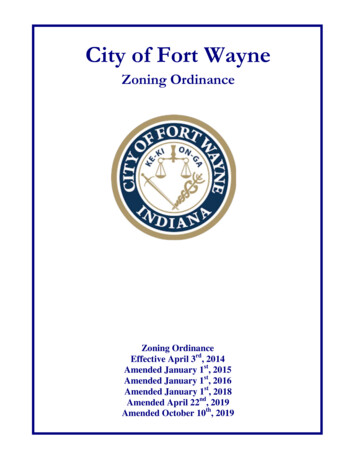
![[2017-2021 STRATEGIC PLAN ] - John Bel Edwards](/img/25/20172021lasubstanceabusepreventionstrategicplan.jpg)
